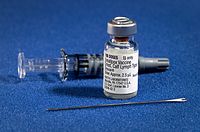
Photo from wikipedia
Outer membrane vesicles (OMVs) are nanoscale spherical vesicles released from Gram-negative bacteria. The lipid bilayer membrane structure of OMVs consists of the similar components as bacterial membrane and thus has… Click to show full abstract
Outer membrane vesicles (OMVs) are nanoscale spherical vesicles released from Gram-negative bacteria. The lipid bilayer membrane structure of OMVs consists of the similar components as bacterial membrane and thus has attracted more and more attention in exploiting OMVs' bio-applications. Although the endotoxic lipopolysaccharide on natural OMVs may impose potential limit on their clinical applications, genetic modification can reduce their endotoxicity and decorate OMVs with multiple functional proteins. These genetically engineered OMVs have been employed in various fields including vaccination, drug delivery, cancer therapy, bioimaging, biosensing, and enzyme carrier. This review will first briefly introduce the background of OMVs followed by recent advances in functionalization and various applications of engineered OMVs with an emphasis on the working principles and their performance, and then discuss about the future trends of OMVs in biomedical applications. This article is protected by copyright. All rights reserved.
Journal Title: Biotechnology and bioengineering
Year Published: 2021
Link to full text (if available)
Share on Social Media: Sign Up to like & get
recommendations!